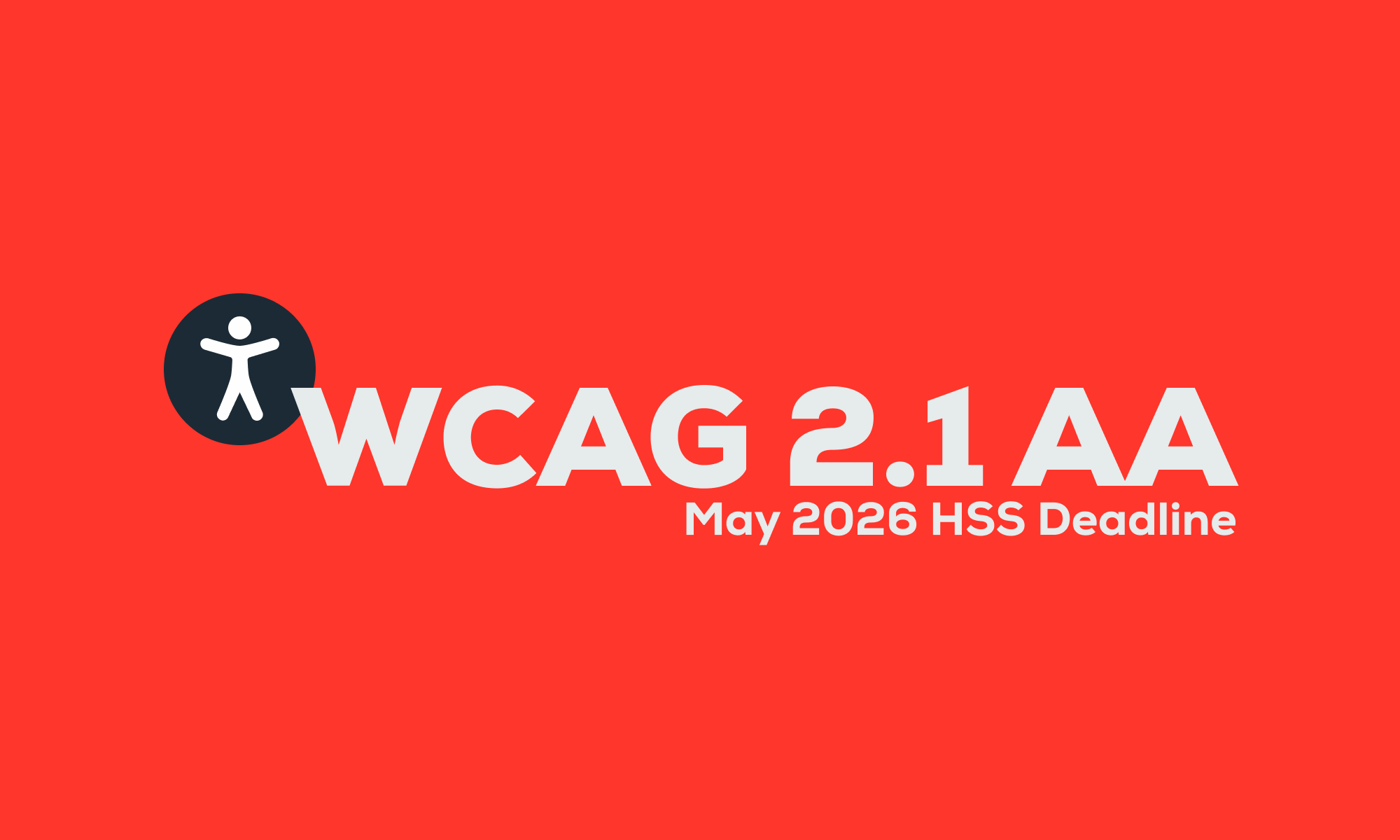May 2026 HSS Accessibility Deadline—Is Your Hospital Ready?
Health System websites will need to comply with updated Accessibility requirements by May 2026.

There have been numerous lawsuits filed against healthcare organizations for failing to meet web accessibility standards. A new ruling (May 2024) by the Department of Health and Human Services (HHS) ups the ante on accessibility requirements and sets a May 2026 deadline. That’s a small window for complying with these updated standards to minimize risk for your organization.
Past guidelines were a bit vague. That is no longer the case. They are now very specific about how accessibility will be evaluated as well as to what and who it applies to.
What changed?
In early 2024, the Department of Health and Human Services (HHS) ruled that all healthcare organizations must comply with WCAG 2.1 AA standards for websites and digital communications (including mobile applications) by May 11, 2026. Organizations with less than 15 employees have an extra year (until May 10, 2027) to comply.
PS: The ADA created a practical factsheet that summarizes the new ruling.
What does WCAG 2.1 AA mean?
While there are a lot of things to consider, WCAG is based on 4 main principles regarding digital content known as “P.O.U.R” (Perceivable, Operable, Understandable, Robust). Here’s a quick summary of what each one means:
- Perceivable
Information and UI components must be presented in ways users can perceive (e.g., text alternatives for images, captions for videos, adaptable content). - Operable
Users must be able to navigate and interact with the interface (e.g., keyboard accessibility, enough time to read and use content, no seizure-inducing elements). - Understandable
Content and operation should be easy to comprehend (e.g., clear language, predictable navigation, input assistance for errors). - Robust
Content must be compatible with current and future technologies, including assistive devices (e.g., proper HTML structure, ARIA roles).
For each of these principles, there are 3 levels of compliance, A, AA and AAA. It is referred to as a "success criteria”. Each level increases in sophistication to make the content more accessible. For example, a video recording must have captions to meet Level A. Captions must be available on live video to meet level AA and a sign language interpreter presented as a synched media would be considered AAA level.
Does this apply to my organization?
If you're a healthcare provider, chances are high it applies to you.
This ruling singles out public hospitals and public healthcare clinics. However, Section 504 prohibits discrimination based on disability in programs that receive Federal financial assistance from the HHS as well.
Since CHIP, Medicaid and Medicare are part of these programs, any healthcare provider benefiting from these would also be included. Most of the following organizations are therefore on the hook:
- Hospitals
- Clinics
- Long-term care facilities
- Mental health treatment centers
- Dental and vision providers
- HMOs
- Educational institutions that provide healthcare training
Take note that this applies not only to your website and patient portals, but also to your mobile apps.
Risks of non-compliance
Non-compliance with the HHS’s mandate to meet WCAG 2.1 AA standards poses significant risks for healthcare organizations. This includes legal challenges, financial burdens, and reputational harm.
Legal consequences
Failure to adhere to these accessibility standards can result in legal action under the Americans with Disabilities Act (ADA) and Section 504 of the Rehabilitation Act. Several healthcare entities got sued for ADA compliance in the past.
Financial Penalties
Beyond legal fees, non-compliance can lead to substantial financial penalties. Settlements have required organizations to not only update their digital platforms but also pay damages.
Reputational damage
Non-compliance can erode trust among patients and the public. Lawsuits or government actions can harm your reputation. This may reduce patient trust and hurt patient numbers.
Preparing for 2026: A compliance roadmap
Here are the steps we recommend to making your website compliant with the updated accessibility guidelines:
1. Audit your current website
While you can do this yourself, it’s best to work with a partner that is knowledgeable with web accessibility and WCAG 2.1 AA standards. Online tools for determining accessibility can provide a good starting point, but it still requires some manual work by experts.
Timeframe: This usually takes about 2-4 weeks to complete.
2. Make the required changes to your website
Based on how your current web environment was built and how your team produces content, this might be a simple or complex task. Most of the work will involve backend code but some is also relevant to the content itself (ex: alt text for images, etc).
Timeframe: Because of the variability of the scope of this work, it could take weeks or even months to get this done. Time is of the essence.
3. Train your team to prevent future issues
Train your content team on accessibility standards. This is an ongoing process. Make sure your content workflow includes quality checks for accessibility. Your vendors should also be alerted to the standards they must adhere to.
Bonus points for appointing a person accountable for accessibility on your team. This person will develop a knack for spotting transgression and will be the quickest response in case of an incident.
Timeframe: While the training itself can be accomplished in a matter of days, making sure you proactively comply is an ongoing effort.
4. Monitor your digital assets to actively make sure you stay compliant
There’s plenty of tools that scan your website for accessibility issues. This does not replace manual testing, but can help catch low hanging fruits.
Protect your organization: The time to comply is now
Since complying with the HSS mandate has a clear deadline and specific requirements, time is of the essence to get this done as quickly as possible. Getting this done fast is a small price to pay to protect your healthcare organization from the potential lawsuits or penalties that you expose yourself due to non-compliance.
Keep in mind that being digitally accessible is also a way to make sure your website is valuable to the vast majority of the population and allows your organization to cater to more patients.
If you’d like to find out more about how accessibility audits can help you stay ahead of the May 2026 deadline, don’t hesitate to get in touch.
